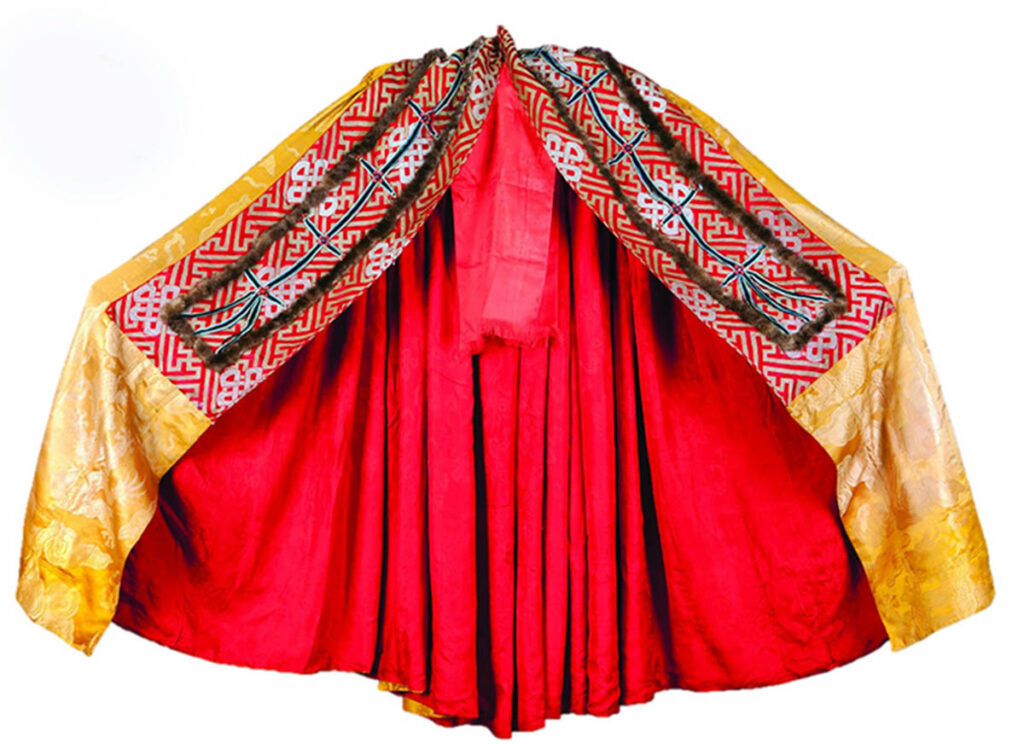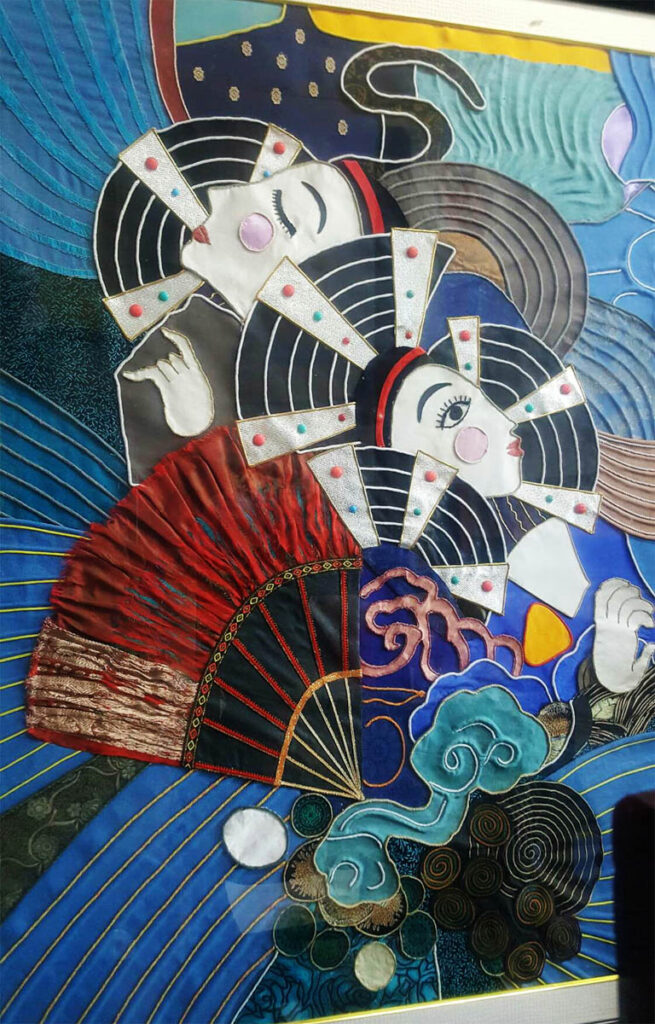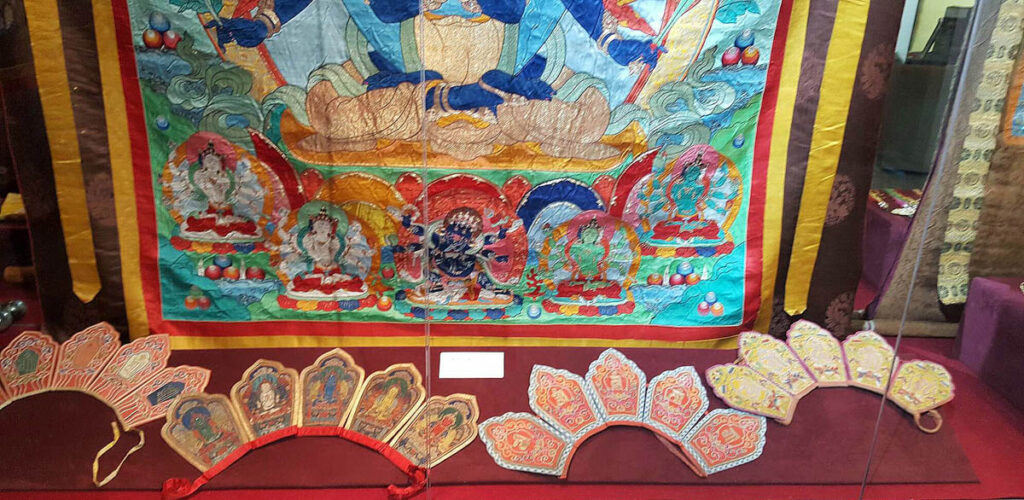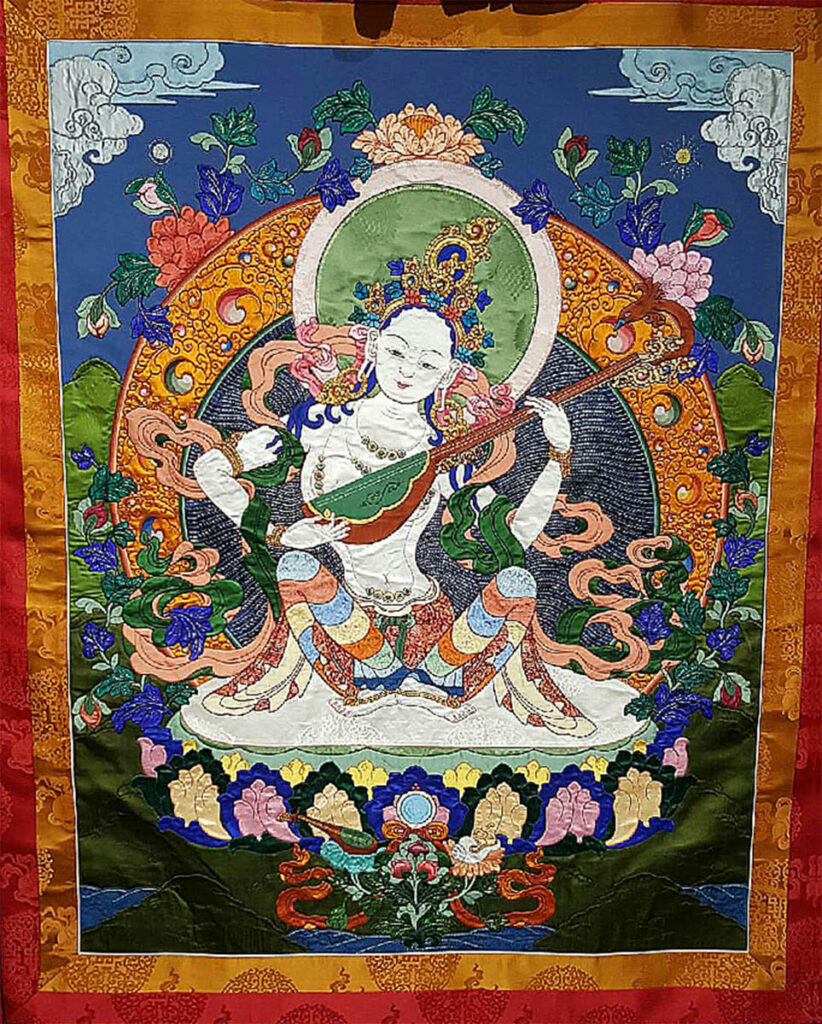
Buddhist Goddess of Culture from the nineteenth century; Zeert naamal made of silk applique and gold and silver threads
Jagdagtseren Serjkhuu writes about the exquisite Mongolian embroidery tradition of Zeert Naamal, that she is trying to rescue.
Silk art has a history of more than 3,000 years and has been enriched by the culture and customs of many countries across the world. It is still relevant today.
The history of silk art, admired for its durability and luxury, holds a special part of the world history of the Silk Road trade among new discoveries and conquests.
There are two types of art with different unique methods developed in close connection with each other.
Tanka is one of many unique arts developed on the basis of centuries of the rich history of Asian culture and handicrafts and deep respect for Buddhism. In some Asian countries, this unique handicraft, which began in the seventh century, is well known in the world as sewing and painting.
- carpet from the tomb of a Hun nobleman found in the 3rd century BC
Additionally, the art of Zeegt Naamal, also known as Mongolian Silk Embroidery, is a luxurious exotic art called appliqué.
Mentioning of Tanka art here is often confused with Zeegt naamaal art. However, it cannot be denied that two types of art with two different unique methods have developed in close connection with each other.
Here we will mention in detail about this special art, which grew out of the nomadic lifestyle of the Mongols in Central Asia and reached its peak of development until the beginning of the twentieth century.
The Mongolian people live in harmony with the four seasons based mainly on animal husbandry. That use not only leather and wool from animal husbandry widely in their daily life but also make many decorative household items. The main method of silk painting art was born here.
The art of carding is to prepare animal hair by rubbing and softening it into a fine thread and then layering it to make it thicker. In the beginning, it was a simple household item, and gradually it became widely used in the decoration of household items
In the following historical years, the art of depicting Zeeg became more and more perfect. Zeeg was made of fine silk threads in many ways, and it became a fine thread of decoration in the palaces of the nobles. It is clear from the archeological findings that Zeegt Naamal art was further enriched during the conquest of Great Mongolia and the Silk Road connecting the east and west.
There are many Zeegt Naamal unique ornaments found in the hirgus (tomb) of the great princes found in Mongolia up to the eighteenth century. Besides, there are many clothes made of silk braiding by carefully processing the silk thread and melting gold and silver threads.
- Darjaa Uranchimeg, The Dream It is a beautiful example of modern Zeegt Naamal
Buddhist teachings occupy a deep place in the art and life thinking of Asian civilised countries. In this sense, religious Lagshin (all the graphic and aesthetic rules to be respected in each representation of the image of Buddha) also inspired many rich works in the nineteenth and twentieth centuries with respect to Taalal (Buddhist concept of the ethical values that lead to peace, harmony and happiness, certain values such as goodness and honesty are universal).
Under the auspices of the great queen of Mongolia, the best embroidered were selected throughout the kingdom and invited to come and make splendid images on the silk by cutting and starching them. The art of decoration was also at the height of its profound transformation into a precise and perfect form.
At that time, not only in Mongolia, but also in many neighbouring Buddhist countries, the art of making idols of God was developed in their own unique ways, and it is the same now. An interesting article by Gary Wornell called “An unbroken thread” mentions this fact.
A foreign tourist who visited Mongolia in the nineteenth century was admiring to see the maids of the Queen’s Palace who were sitting with respect during long hours making with great care and patience beautiful gold and silver silk Zeegt Naamal.
With the passage of time, the art of silk weaving in Zeegt is fading. A simple knot of thread that originated from the primitive lifestyle of the first nomads has become an independent technique of silk art consisting of netting, with fine decoration of gold and silver.
Although many changes in history and time have affected the art of silk embroidery, during the socialist society, artworks were developed in reflection of social norms and behaviour of the time.
In general, the creation of a silk embroidery includes all types of our national hand embroidery, in addition to the art of Zeeg.
Today, there are arts that have evolved and changed by the effect of globalization of the world, and some types are faded and being forgotten, and some are enriched while keeping their patterns.
Currently, in our country, the art of Zeeg is losing its nature of heritage and has faded significantly. The schools don’t teach the art of Zeeg and there are no specialized classes in vocational art schools. It is sad to note that knowledgeable art teachers are not fully transferring their knowledge and experience. A new generation of young people thinks of it as a religious art and this creates a lack of continuity and support.
As a researcher and artist, my goal is to promote and develop this ancient and precious form of Mongolian art in a classical and free form. I am grateful for writing this article and sharing my opinion with many readers of Garland magazine.r
About Jagdagtseren Serjkhuu
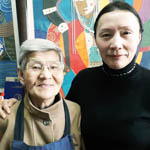 I was born and raised in Ulaanbaatar. I am a designer, researcher and historian of Silk Art in Asia specialising in Zeegt Naamal (Applique). I first became interested in Ikebana, the Japanese floral art, whose rare and sacred philosophy I appreciated very much. This led me today to the art of applique. I studied at INALCO (Institut National des Langues et Civilisations Orientales) in Paris and have since conducted research work with the Buddhist Temple of Ulaanbaatar, studying old pieces and archives. I have completed the Ancient Art course at the Mongolian Buddhist University and I continue to improve my skills in the art of applique.
I was born and raised in Ulaanbaatar. I am a designer, researcher and historian of Silk Art in Asia specialising in Zeegt Naamal (Applique). I first became interested in Ikebana, the Japanese floral art, whose rare and sacred philosophy I appreciated very much. This led me today to the art of applique. I studied at INALCO (Institut National des Langues et Civilisations Orientales) in Paris and have since conducted research work with the Buddhist Temple of Ulaanbaatar, studying old pieces and archives. I have completed the Ancient Art course at the Mongolian Buddhist University and I continue to improve my skills in the art of applique.
I have studied applied embroidery history and techniques for years, in France and in Mongolia, where I met Mrs Darjaa Uranchimeg, a member of Mongolian Craftsmen Union, a famous Zeeg artist, experienced in applique embroidery, who is recognized as an expert in her field. We share the same passion for our historical heritage and we want to keep this admirable culture alive and make it evolve in modernity. For this purpose, we are building a project for a training institute for embroidery and ancestral techniques in Zeeg. We want to keep this magnificent cultural heritage alive and make it evolve in a modern way, adapted to our contemporary society. We will we design and produce modern designed Zeeg, addressing public and private customers. It will also be an opportunity to train young people and give them a job.
We are currently in contact with cultural institutions in Mongolia and are also looking for financial support because we need funding to launch our project in good condition.



